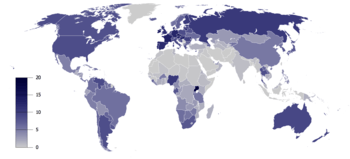Alcohol in Iran
Alcohol in Iran is prohibited for Muslim citizens by law since the establishment of Islamic Republic government in 1979.[1]
Non-Muslim citizens are granted a limited permission to produce alcohol for consumption within their community. This exemption, however, also leads to an attitude towards them (especially Iranian Armenians) as alcohol dealers, and a segment of black market alcohol in Iran comes through the minority community.[2][3][4]
History
Wine has played an important role in Persian culture and history ranging from administration of the earliest empires to religion and Persian literature.[5]
Law
Under the law, it is forbidden for Iran's Muslim citizens to consume alcohol. Much of the alcoholic beverages consumed by Iranian citizens is smuggled from Iraqi Kurdistan into Iran.[6]
Allowances for non-Muslims
Additionally officially recognized non-Muslim minorities are allowed to produce alcoholic beverages for their own consumption and for religious rites such as the Eucharist (two of the four religious minorities guaranteed representation in the Majlis, the Armenians and Assyrians, are Christian, the former being chiefly Armenian Apostolic).
This practice is not respected in some political cases, such as that of Afarin Neyssari and her husband, Karan Vafadari, as they have been arrested, among other charges, for having and serving alcohol during the mixed gatherings in their home though they are Zoroastrians, a monotheistic religion that predates Islam.[7]
Bringing alcohol into Iran is banned.
Drunk driving
In 2011-2012, Iran's police withdrew the driving licenses of 829 drivers, including 43 women, who had failed to pass alcohol and drug tests. Alcohol tests taken from drivers in Tehran in the period of 20 April-20 May 2012 showed that 26% of them were drunk.[8] Because the dominated Muslim state has no discothèques or nightclubs, it all takes place at home, behind closed doors.
Illegal sources
The 2010 study Substance Use Among Migrants: The Case of Iranians in Belgium notes that alcohol is acquired illegally in three different ways: purchased from ethnic minorities (particularly Armenians), personal home production including adding fermentants to non-alcoholic beer, or illegal imports largely through Iraq.[9]
Non-alcoholic alternatives
Iran's prohibition of alcoholic drinks creates a large demand for non-alcoholic beer. Anti-smuggling plans by the Iranian Government, coupled with awareness campaigns against the consumption of cola carbonates and campaigns encouraging the drinking of non-alcoholic beer, further boosted demand in 2010. More young adults in Iran are tending to non-alcoholic beer, following widespread media coverage regarding its health benefits. These health advantages play a major part in the promotional activities of most major firms.[10]
See also
References
- ↑ Marjolein Muys (1 April 2010). Substance Use Among Migrants: The Case of Iranians in Belgium. Asp / Vubpress / Upa. pp. 78–. ISBN 978-90-5487-564-2.
- ↑ Afshin Molavi (12 July 2010). The Soul of Iran: A Nation's Struggle for Freedom. W. W. Norton. pp. 95–. ISBN 978-0-393-07875-6.
- ↑ A. Christian Van Gorder (2010). Christianity in Persia and the Status of Non-muslims in Iran. Rowman & Littlefield. pp. 195–. ISBN 978-0-7391-3609-6.
- ↑ Kevin Boyle; Juliet Sheen (7 March 2013). Freedom of Religion and Belief: A World Report. Routledge. pp. 423–. ISBN 978-1-134-72229-7.
- ↑ J.B. (28 September 2016). "Why wine is integral to Persian culture". The Economist. Retrieved 28 September 2016.
- ↑ Saeed Kamali Dehghan (25 June 2012). "Iranian pair face death penalty after third alcohol offence | World news". London: The Guardian. Retrieved 2013-06-11.
- ↑ "Family Breaks Silence as Iran Detains Owners of Tehran's Aun Gallery". www.artforum.com. Retrieved 2018-05-28.
- ↑ Pourparsa, Parham (2012-06-20). "BBC News - Iran's 'hidden' alcoholism problem". Bbc.co.uk. Retrieved 2013-06-11.
- ↑ "Alcohol in Iran: All You Need to Know | 1stQuest Blog". 1stQuest Blog. 2018-05-30. Retrieved 2018-06-14.
- ↑ "Alcoholic Drinks in Iran". www.euromonitor.com. Retrieved 29 May 2011.
